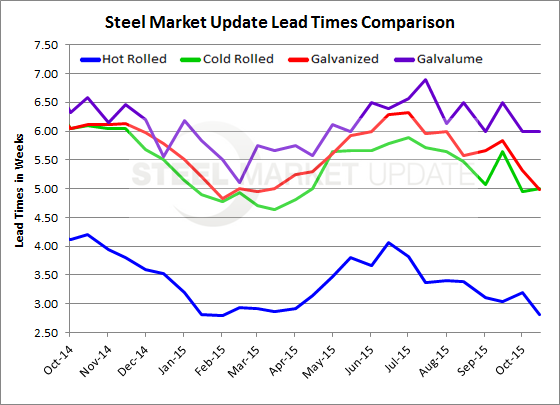SMU Data and Models

Steel Mill Lead Times: No Change
Written by John Packard
October 22, 2015
Buyers and sellers of flat rolled steel are reporting average lead times on hot rolled, cold rolled, galvanized and Galvalume steels as being essentially unchanged from what we reported at the beginning of the month.
However, when looking at the graphic below you can clearly see lead times have been in decline since the early summer months and are now at, or very near, their one year low point.
Hot rolled lead times moved fractionally lower to 2.82 weeks versus the 3.19 week average reported at the beginning of October. Hot rolled lead times are now 1.3 weeks shorter than what was being reported by SMU one year ago.
Cold rolled lead times remained the same as what was being reported at the beginning of the month. The 5.0 week lead average lead time is one week shorter than what we saw for an average during the middle of October 2014.
Galvanized lead times slipped slightly and at 4.98 weeks are very close to the lowest levels of the year and is slightly over one week shorter than what we reported as the GI average last year at this time.
Galvalume lead times remained the same as what was reported at the beginning of the month. The 6.0 week average is about one half a week shorter than what we reported AZ average lead times to be in mid-October 2014.
Weak or weakening lead times, in SMU opinion, is seen as one of the main culprits keeping prices from stabilizing.
To see an interactive history of our Steel Mill Lead Time data, visit our website here.

John Packard
Read more from John PackardLatest in SMU Data and Models

SMU’s June at a glance
A look at SMU data for the month of June.

SMU Survey: Buyers’ Sentiment rebounds from multi-year low
Both of SMU’s Steel Buyers’ Sentiment Indices edged higher this week. Current Sentiment rebounded from a near five-year low, while Future Sentiment rose to a two-month high

SMU flat-rolled market survey results now available
SMU’s latest steel buyers market survey results are now available on our website to all premium members.

SMU Survey: Sheet lead times pull back after early-June blip, plate holds
Following the uptick seen two weeks ago, lead times eased this week for all four sheet products tracked by SMU, while plate lead times held steady, according to this week’s market survey.

SMU Survey: Pricing power abruptly shifts to steel buyers
The majority of steel buyers responding to our latest market survey say domestic mills are more willing to talk price on sheet and plate products than they were earlier this month. Sheet negotiation rates rebounded across the board compared to early June, while our plate negotiation rate hit a full 100%.

